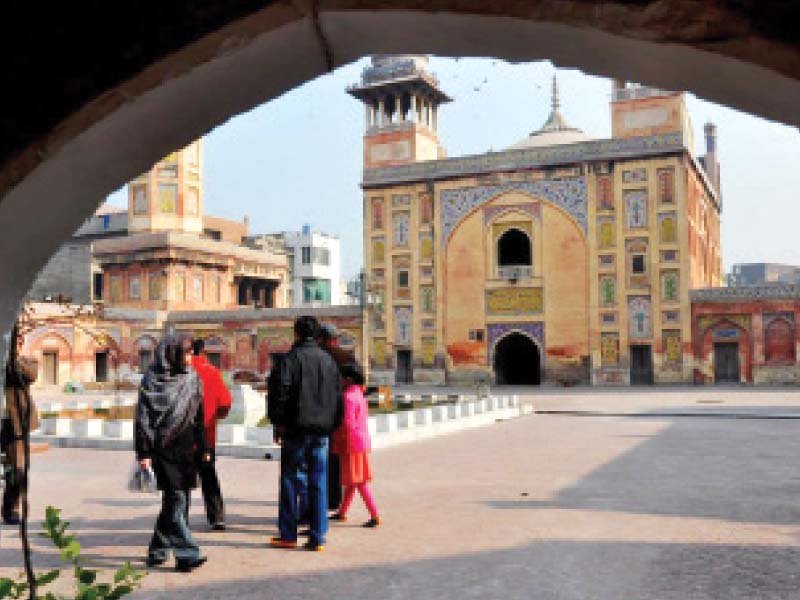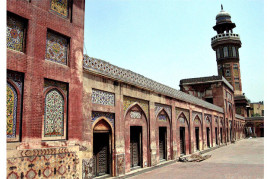
LAHORE: Calligraphy is ‘how the ink bleeds.’ In Islamic architecture, the esoteric motifs and calligraphy seem to compensate for the figurative art and sculpture that is the jewel of western historical architecture. It is a streak across time to bridge the centuries passed by and the present. One wonders if it is a skillful, yet cautious and deliberate reflection of artist’s desire to paint a beautiful face, from which he was otherwise prohibited. He dances with every stroke of the brush and instills life in the writings on the wall. It seizes the reader’s attention and thrusts the lance of realisation that no matter how vast the treasures of a king are, the trembling eagerness of time to pass, leaves them behind so that only as a story painted in letters remains. The poetic merit is best described by HG Wells, albeit comically:
“the prettiest little squiggles of black looked at in right light and yet consider the blow they can give upon the heart.”
Architects tell us to read architecture and not just see it. It helps if you are familiar with the language written on the walls, whether of a mosque, a palace or the tomb of a monarch. It is easy to ‘read’ these buildings when you have faith in the writings. I am always reminded in this regard, of the verse on the walls of Al-Hambra, Wa la Ghalib Ill-Allah (No conqueror but Allah). When the last Muslim ruler of Granada surrendered to King Ferdinand, his queen fell in love with the palace and wanted to preserve the verse on the walls and facades, though much else was to be remodelled. In all likelihood, she did this out of her appreciation of art. To the believing heart, it was the promise veiled in the beauty of the script that prevailed.
In no place of worship are the inscriptions and themes casually placed art. These are employed thoughtfully to tell a tale and convey a message. Masjid Wazir Khan has one of the finest works of calligraphy that I was eager to see once again. Also, I almost wanted to rave to my American-born children that this heritage of ours was as rich as Cordoba or Hagia Sophia.
As we walked the short distance from Delhi Gate to the Shahi Hamam and to Masjid Wazir Khan, we saw weather-beaten, dust-covered buildings and shops on the two sides of the road that have stood the test of time. Wazir Khan had declared these buildings an endowment for the mosque’s upkeep. He left an imperative that under no circumstances were these to become the property of anyone “until the day when God shall assume heritage of all lands, for He is the best of inheritors.”

This account dated 1051 Hijri, is preserved in history as is the fact that the authorities did not honour it for long. John Lockwood Kipling, father of Rudyard, wrote about this in 19th century. The mosque was completed in 1045 i.e. 1635 AD as is evident by the date recorded on the Kalimah Tayyaba calligraphy on the central arch at the main entrance.
We do not know who the architect of the mosque was. Ali Mardan Khan is one of the names connected to it, but without any tangible eviction. The masjid was conceived and founded of course, by the then governor of Lahore, appointed by Emperor Shah Jahan, Hakim Sheikh Ilmud Din alias Wazir Khan who hailed from Chiniot. Wazir Abad town in the Punjab, too, is named after him.
As we entered the iron gates that lead to a compound of brightly repainted bricks, I could not help but notice a very inept, metallic silver-on-red modern sign board on the shrine of Syed Muhammad Ishaq Gazrooni, a Sufi shaikh, also known as Sabz Peer (the Green Elder). The mosque was built on the site of his shrine/dargaah. We quickly forgot how out-of-place the restoration seemed as we faced the bounteous view of five arches leading to the prayer hall. This feature, we were told, is a repetition from the previously built Mariyam Zamani Masjid. It was later reproduced in full glory in the construction, on a much larger scale, of the Badshahi Masjid. Until the Badshahi Masjid was built, Masjid Wazir Khan was the main mosque in Lahore used by the royalty, diplomats and the plenipotentiary.
Students of architecture learn that the arches in a mosque are meant to remind one of the glory of the Worshipped. In fact two characteristics are common to most religious structures. These are elevated edifices, i.e. domes, pillars, minarets and arches that signify the divinity of the exalted worshipped, and the decorative elements that are an aide to the worshipper. The latter consists of calligraphy in mosques and sculptures in temples and cathedrals. The façade and the interior of the mosque boast of the artists’ creativity. More than one calligraphist were hired to accomplish the work and some of the writings bear the signatures of the artist.
Inscribed on the walls are Quranic verses and paintings depicting their subject. The ayaat come those from Surah Al- Baqarah, Tauba, Aal-i-Imran and Al-Fath. The central arch is decorated with the Aayat-ul-Kursi (the Throne Verse).
The art work in motifs of fresco and radiant hues of glazed tile is intricate. The colours gleam through the dust of time, but give at best an incomplete account of the original splendour of the place.
As we exit the mosque, the bold yellow and blue colours of the writing in Persian leave us humbled:
Muhammad-i- Arabi kaabru-i-har do sara’st
Kasey keh khaak-i-darash neest khaak bar sar-i-ou
[Muhammad of Arab is the esteem of both this world and the hereafter
Dust upon the head which is not the dust of his threshold]
My ten year old wanted me to translate the verse. I told her the literal meaning. She wanted me to elaborate and I did, but in doing so I felt the gripe of the times we live in. I do not even know how many mosques are there in Lahore today but I know that for some, going to their places of worship involves risking their lives.
“People would come from all over the city to pray here.”
As our guide proudly uttered, I knew the question that was coming from a curious mind:
“Mom, how many mosques are there in Lahore today?”
“Not enough for us to show that we have remotely understood the love of the Creator for his Prophet (peace be upon him) and certainly not enough my dear to show that we are the dust of the dust of the dust….of his feet”
I left the mosque pondering upon the verse. When someone chose to have it transcribed here, a few hundred yards from this stood another mosque, named after a Muslim emperor’s Hindu wife who was free to practice her religion.
F Shereen, MD, is a Missouri-based physician, currently living and practicing rheumatology in the USA.
She tweets as @FShirinMD
Published in The Express Tribune, June 12th, 2016.















































COMMENTS
Comments are moderated and generally will be posted if they are on-topic and not abusive.
For more information, please see our Comments FAQ